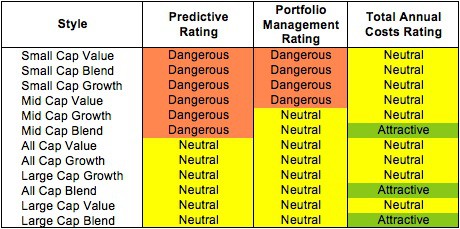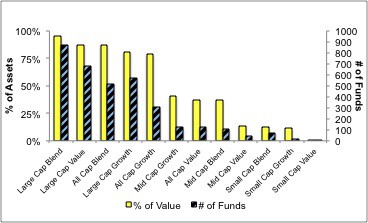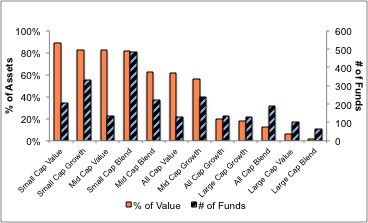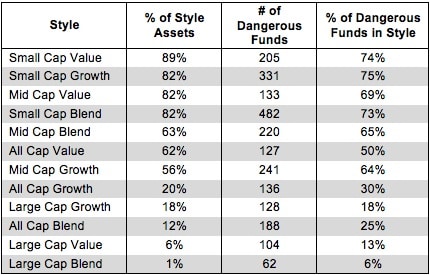No fund style earns better than a Neutral rating going into 3Q13. My style ratings are based on the aggregation of my fund ratings for every ETF and mutual fund in each style.
Investors looking for style funds that hold quality stocks should look no further than the Large Cap Blend, Large Cap Growth, Large Cap Value, All Cap Blend and All Cap Growth styles. Only these styles house Attractive-or-better rated funds. Figures 4, 5, 6 and 7 provide details. The primary driver behind an Attractive fund rating is good portfolio management, or good stock picking, with low total annual costs.
Note that the Attractive-or-better Predictive ratings do not always correlate with Attractive-or-better total annual costs. This fact underscores that (1) low fees can dupe investors and (2) investors should invest only in funds with good stocks and low fees.
See Figures 4 through 13 for a detailed breakdown of ratings distributions by investment style. See myfree ETF & mutual fund screener for rankings, ratings and free reports on 7000+ mutual funds and 400+ ETFs. My fund rating methodology is detailed here.
All of my reports on the best & worst ETFs and mutual funds in every sector and investment style are available here.
Figure 1: Ratings For All Investment Styles
To earn an Attractive-or-better Predictive Rating, an ETF or mutual fund must have high-quality holdings and low costs. Only 106 style ETFs and mutual funds meet these requirements, which is only 1.7% of all style ETFs and mutual funds.
SunAmerica Focused Dividend Strategy Portfolio (FDSWX) is my top Large Cap Blend mutual fund. It gets my Very Attractive rating by allocating over 79% of its value to Attractive-or-better-rated stocks.
Western Union (WU) is one of my favorite stocks held by FDSWX and earns my Very Attractive rating. Western Union has a return on invested capital (ROIC) of 27%, putting it in the top quintile of all companies I cover. WU has also been earning positive economic earnings since it went public in 2006. Western Union’s 4% compounded annual profit (NOPAT) growth may not attract investors in droves, but with its profit margins of 20% and high ROIC, it is certainly positioned for long-term growth and has the ability and infrastructure to outdo any major competitor in the money transfer business. The firm’s recent successful expansion into India bodes well for future prospects. At its current valuation of ~$17.33/share, WU has a price to economic book value ratio of 0.7, implying a permanent 30% decline in NOPAT. WU may not be a high growth company, but it should easily surpass the low expectations the market has for it.
Clarity Fund (CLRTX) is my worst-rated All Cap Blend mutual fund. It gets my Very Dangerous rating by allocating over 27%% of its value to Neutral-or-worse-rated stocks, and to make matters worse, charges investors annual costs of 5.22%.
Big 5 Sporting Goods (BGFV) is one of my least favorite stocks held by CLRTX and earns my Dangerous rating. Big 5’s profits (NOPAT) have fallen by over 1% compounded annually since 2002, and its return on invested capital (ROIC) is also down to 6.5% from 12% in 2002. Most alarming is the fact that BGFV has earned increasingly large negative economic earnings over the past 5 years. The firm’s weighted average cost of capital (WACC) of 8% exceeds its return on capital, meaning that the firm is failing to create value for shareholders. Even with all of this pointing to a decline for BGFV, the stock is currently trading at ~$23.40/share, meaning that the firm would need to grow profits at over 6% annually for the next 13 years to justify its current stock price. Seeing as BGFV has failed to grow its profits at all over the past 10 years, this seems unlikely. The stock is far too expensive for investors to buy in now and the risk for a fall is too great.
Figure 2 shows the distribution of our Predictive Ratings for all investment style ETFs and mutual funds.
Figure 2: Distribution of ETFs & Mutual Funds (Assets and Count) by Predictive Rating
Figure 3 offers additional details on the quality of the investment style funds. Note that the average Total Annual Cost of Very Dangerous funds is almost 4 times that of Very Attractive funds.
Figure 3: Predictive Rating Distribution Stats
 * Avg TAC = Weighted Average Total Annual Costs
* Avg TAC = Weighted Average Total Annual Costs
Source: New Constructs, LLC and company filings
This table shows that only the best of the best funds get our Very Attractive Rating: they must hold good stocks AND have low costs. Investors deserve to have the best of both and we are here to give it to them.
Ratings by Investment Style
Figure 4 presents a mapping of Very Attractive funds by investment style. The chart shows the number of Very Attractive funds in each investment style and the percentage of assets in each style allocated to funds that are rated Very Attractive.
Only 1 investment style fund earns our Very Attractive rating.
Figure 4: Very Attractive ETFs & Mutual Funds by Investment Style
Figure 5 presents the data charted in Figure 4.
Figure 5: Very Attractive ETFs & Mutual Funds by Investment Style
Figure 6 presents a mapping of Attractive funds by investment style. The chart shows the number of Attractive funds in each style and the percentage of assets allocated to Attractive-rated funds in each style.
Note that the Large Cap Value, Large Cap Blend, Large Cap Growth, All Cap Blend, and All Cap Growth are the only styles with Attractive-rated funds.
Figure 6: Attractive ETFs & Mutual Funds by Investment Style
Figure 7 presents the data charted in Figure 6.
Figure 7: Attractive ETFs & Mutual Funds by Investment Style
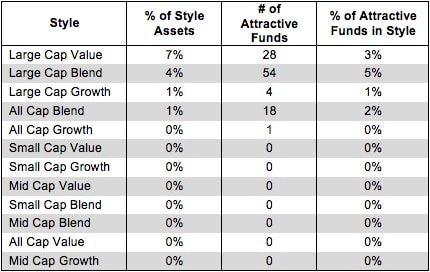 Source: New Constructs, LLC and company filings
Source: New Constructs, LLC and company filings
Figure 8 presents a mapping of Neutral funds by investment style. The chart shows the number of Neutral funds in each investment style and the percentage of assets allocated to Neutral-rated funds in each style.
Figure 8: Neutral ETFs & Mutual Funds by Investment Style
Figure 9 presents the data charted in Figure 8.
Figure 9: Neutral ETFs & Mutual Funds by Investment Style
Figure 10 presents a mapping of Dangerous funds by fund style. The chart shows the number of Dangerous funds in each investment style and the percentage of assets allocated to Dangerous-rated funds in each style.
It is concerning that the percentage of assets in Dangerous Funds for almost half of investment styles is higher than the percentage of Dangerous funds overall in these styles. This is a sign that investors are disproportionately allocating to funds with poor holdings.
Figure 10: Dangerous ETFs & Mutual Funds by Investment Style
Figure 11 presents the data charted in Figure 10.
Figure 11: Dangerous ETFs & Mutual Funds by Investment Style
Figure 12 presents a mapping of Very Dangerous funds by fund style. The chart shows the number of Very Dangerous funds in each investment style and the percentage of assets in each style allocated to funds that are rated Very Dangerous.
Judging by the low % of style assets allocated to Very Dangerous funds across all styles, investors have done a good job of avoiding Very Dangerous funds in general.
Figure 12: Very Dangerous ETFs & Mutual Funds by Investment Style
Figure 13 presents the data charted in Figure 12.
Figure 13: Very Dangerous ETFs & Mutual Funds by Investment Style
 Source: New Constructs, LLC and company filings
Source: New Constructs, LLC and company filings
André Rouillard and Sam McBride contributed to this report.
Disclosure: David Trainer owns WU. David Trainer, André Rouillard and Sam McBride receive no compensation to write about any specific stock, sector or theme.

